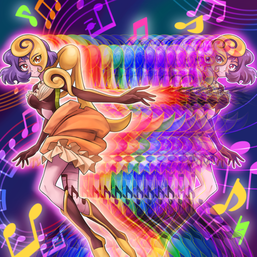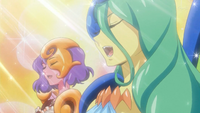Melodious
| Melodious | |||||||||||||
|---|---|---|---|---|---|---|---|---|---|---|---|---|---|
 "Aria the Melodious Diva" in the artwork of "Melodious Illusion". | |||||||||||||
| Japanese |
| ||||||||||||
| French |
| ||||||||||||
| German |
| ||||||||||||
| Italian |
| ||||||||||||
| Korean |
| ||||||||||||
| Portuguese |
| ||||||||||||
| Spanish |
| ||||||||||||
| |||||||||||||
| Anime appearances | |||||||||||||
| Lists | |||||||||||||
"Melodious" (
Contents
Design
Appearance
"Melodious" monsters are female creatures wearing flowing, regal clothing. They also feature various music-related objects on their bodies such as musical notes. Another example is that the wings of "Mozarta the Melodious Maestra" have a piano-key design to them. The "Melodious Diva" and "Melodious Songstress" monsters have varied appearances from child-like to young woman, the "Melodious Maestra" monsters have adult-like appearance, while the "Melodious Choir" monsters have child-like appearance. The "Melodious Choir" monsters also incorporate floral design in them, referring to Zuzu Boyle's bracelet motif. In addition, "Mozarta" and "Shopina" have butterfly wings/seats which represents the Symbiosis Relationship between butterflies and flowers.
Etymology
The archetype's Japanese name, "Gensō" (
Members
| Title | Melodious | Name origin |
|---|---|---|
| Choir | Bloom Diva | Diva |
| Bloom Prima | Prima ballerina/prima donna | |
| Composer | Bloom Harmonist | Harmony |
| Diva | Aria | Aria |
| Canon | Canon | |
| Elegy | Elegy | |
| Opera | Opera | |
| Score | Score | |
| Serenade (OCG: Serena) | Serenade | |
| Sonata | Sonata | |
| Tamtam | Tam-tam | |
| Grand Choir | Flowering Etoile | Danseuse étoile |
| Maestra | Bacha (OCG: Spectacular Bach) | Spectacle + J.S. Bach |
| Mozarta (OCG: Prodigy Mozart) | Prodigy + Mozart | |
| Schuberta (OCG: Meisterin Schubert) | Meisterin + Schubert | |
| Shopina (OCG: Laureate François) | Laureate + Frédéric François Chopin | |
| Songstress | Couplet | Couplet |
| Refrain | Refrain | |
| Solo | Solo | |
| Soprano | Soprano |
Playing style
"Melodious" is a theme focused on Special Summoning monsters to the field to gain various benefits and achieve wins through their Fusion Monster boss monsters. Several monsters in the theme have effects that allow them to Special Summon themselves or other monsters in the theme, such as "Sonata the Melodious Diva" and "Mozarta the Melodious Maestra", while other monsters give benefits to Special Summoned Melodious monsters such as "Aria the Melodious Diva" and "Elegy the Melodious Diva".
The later duo, notably, form a strong lockdown strategy that gives all "Melodious" monsters you control immunity from battle, effect destruction, and being targeted by card effects when both have been Special Summoned; however the targeting protection includes being targeted by your own card effects so be aware of this. The theme carries with it many different ways to Special Summon both Aria and Elegy to the field; from the Spell Cards "1st Movement Solo" and "Ostinato" to the theme's "Link Monster" "Bloom Harmonist the Melodious Composer" and its effect to Special Summon 2 Melodious monsters with different Levels from the Deck. Through this Aria-Elegy Lock, players can stall out opponents and amass their resources for a more explosive play once all the pieces have been gathered or further disrupt the opponent with cards such as "Archlord Kristya", the only notable outs to the strategy being non-targeting, non-destruction removal options or piercing battle damage. However, the main way the deck can achieve wins is through the explosive power of their various Fusion monsters.
"Melodious" Fusion monsters come in 2 main varieties; the first being members of the "Melodious Maestra" sub-archetype that require any 2 "Melodious" monsters to Fusion Summon and able able to grant the deck stronger monsters as well as good disruption effects, such as the effect of "Schuberta the Melodious Maestra" to banish 3 cards from either player's GY. The second set of "Melodious" Fusion monsters are the "Melodious Choir" monsters, Fusions that take at least 1 "Melodious Maestra" monster as well as 1 or more other "Melodious" monsters to make and are typically the backbone of the theme's damage output, able to summon monsters such as "Bloom Diva the Melodious Choir" which takes no battle damage from the opponent's monsters and is able to inflict damage to the opponent equal to the difference of its ATK to the monster it battles.
With their wave of support from Legacy of Destruction, "Melodious" gained access to a set of Pendulum Monsters that provides the theme with further consistency as well as new Fusion Monsters "Bacha the Melodious Maestra" and "Flowering Etoile the Melodious Grand Choir" that provide more powerful disruption effects and help to secure games quicker.
Recommended cards
Weaknesses
- The "Melodious" monsters share the notion of Special Summoning as their pre-eminent means of strategy, which thus makes them the perfect target for anti-Special Summoning support like "Archlord Kristya", "Aurora Paragon", "Special Hurricane", "Fossil Dyna Pachycephalo" and "Jowgen the Spiritualist", of which the latter three can also destroy such Summoned monsters without the protection of "Elegy"'s effect (though "Elegy" can protect itself from indiscriminate Nukers like "Raigeki Bottle", "Black Rose Dragon" and "World of Prophecy"). More generally, "Reptilianne Servant", "Narrow Pass", "Summon Limit" and "Summon Breaker" can also hog their influence on the field.
- "Melodious" monsters are also LIGHT Fairies, hence giving cards like "Yami", "Penumbral Soldier Lady" (who can defeat every monster in the archetype unpowered with her effect alone) and the "Ally of Justice" and "Koa'ki Meiru" archetypes a chance to predate on the "Melodious.", though cards like "Light-Imprisoning Mirror" will not affect the majority of the "Melodious" monsters, due to their effects being continuous, and therefore not activating. Finally, their heavy dependence on their effects also make them vulnerable to effect negations, make possible through cards such as "Number C107: Neo Galaxy-Eyes Tachyon Dragon" "Tyrant's Tirade", "Skill Drain", and "Angel 07".
- "Stellarknight Triverr" can defeat the "Aria"-"Elegy" lock, since "Triverr's" effect returns all your cards back to the hand without targeting them. "Madolche Queen Tiaramisu" can shuffle them into the deck without targetting them. "Nekroz of Trishula" can banish them without targeting them, Ice Beast Zerofyne can negate their effects without targeting them, "Book of Eclipse" will negate their effects due to their status of being unnamed while face down, and "The Monarchs Stormforth" will allow your opponent to tribute them without targeting the monsters.
